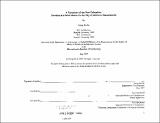A variation of the New Urbanism : provision of a public realm for the City of Attleboro, Massachusetts
Author(s)
Ju, Jeong Jun
DownloadFull printable version (17.29Mb)
Alternative title
Public realm for the City of Attleboro
Advisor
Roy Strickland.
Terms of use
Metadata
Show full item recordAbstract
Born as a reaction to the large suburban development patterns, the New Urbanism has played a role in bringing reconsideration to our built environments for more than a decade. Its ideals and visions can have feasibility through various forms such as housing developments, town center developments, or redevelopment of existing downtown or deteriorating industrial, or commercial areas. However, its implementation has largely depended on new town developments. Through the new town developments, the New Urbanism has revealed some limits and been criticized for them. Under th is circumstance, recognizing its values for our environments, this thesis attempts to apply the ideals to existing built environments, expecting that the incorporation of its ideals into reality can facilitate its ideals to be evaluated and modified. For its testing ground, Attleboro, Massachusetts, is selected because of its opportunities for the application of the New Urbanism and the needs of a revitalization of the downtown area of the city. Determining that the New Urbanism 's primary goal is to provide and enhance a public realm, th is thesis examines how the New Urbanism has conveyed its ideals to establish public environments. From the examination, three models, "Networks, Spatial Sequence, and Activities," are designed to facilitate the New Urbanism's application to existing urban structures. Through the application process such as the models' initial superimposition on the site and further development process from the initial experiments, possible ways to apply the New Urbanism to downtown Attleboro are detected. Based on the result of this process, feasible ways not only to reinforce public environments and improve public life for Attleboro but also to reexamine and remodel the New Urbanism can be determined. Thus, this thesis has attempted to answer the questions: What are the ways to apply the New Urbanism to existing built environments and how can the application facilitate the New Urban ism to be more applicable and viable? This thesis is composed of seven chapters. The first chapter is an introduction of this thesis. The second chapter is a background of this thesis. The third chapter as a theoretical background disbisses the thesis approach and methodology. In the fourth chapter, through case studies of New Urbanists' projects, models are built to facilitate the New Urbanism's application to existing built environments. The fifth chapter as an actual application phase shows experimental processes of applying the models to the site. In the sixth chapter, design proposals are discussed and guidelines to maintain the design intents are suggested. The seventh chapter as a conclusion discusses the ways to realize the ideals of the New Urbanism for our built environment and its feasibility as a paradigm, not a fashion.
Description
Thesis (M.S.)--Massachusetts Institute of Technology, Dept. of Architecture, 1997. Includes bibliographical references (leaves 105-109).
Date issued
1997Department
Massachusetts Institute of Technology. Department of ArchitecturePublisher
Massachusetts Institute of Technology
Keywords
Architecture